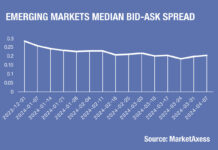 Traders can add more value in analysis and decision-making than they can as connections between systems.
Traders can add more value in analysis and decision-making than they can as connections between systems.
Removing operational bottlenecks allows buy-side traders to provide better and more efficient delivery of trade execution in support of investment goals. The DESK speaks with David Rickard, Director of Rates Trading Solutions at LSEG, to understand just how heads of trading can get the most from their traders through more efficient desktop integration.
How would you characterise the technical challenge faced by buy-side bond traders today?
Buy-side bond traders face several technical challenges today. While the emergence of electronic trading platforms has advanced digital transformation, the trading workflow remains quite fragmented with significant manual intervention at many stages. In several fixed income sub-asset types, traders face difficulty in finding a central source of price transparency and execution. Trading desks still rely on chat messaging services, email and phone calls to enable the exchange of data. This can be particularly challenging during times of market turmoil.
The burden falls to sales and trading desks to manage large volumes of sensitive data critical to pre-trade analysis, price discovery and execution. In addition, while there are a wide variety of tools available to help traders with these challenges, integration remains a challenge. There is significant friction in the day-to-day user experience navigating between trading applications. This presents major problems for traders, under pressure to generate returns, and meet regulatory requirements, amidst difficult market and liquidity conditions.
How is LSEG supporting the combination of components?
LSEG is committed to partnering with our fixed income clients to solve these workflow challenges. We already offer a breadth of leading fixed income products, catering to the entire trading lifecycle. We are actively working to reduce friction in the user experience for our clients, so they can trade more effectively. In practice, this means offering open, interoperable trading solutions. For example, CodeBook is our best-in-class solution for traders and quants focused on automating trading desk workflows. CodeBook is available in our Refinitiv Eikon application and offers traders the opportunity to leverage our APIs and platform services in a development environment for Python scripting.
We want to empower our clients to use our wide variety of pre- and post-trade analytical tools to enrich their own trading workflows. Another example of supporting our clients with workflow integration includes offering Yield Book’s best-in-class analytics in our established Refinitiv Eikon product. This means traders can access a diverse set of fixed income analytics, real-time pricing, news, and charting in a single, open application, without compromising valuable screen real estate.
What are the advantages of this better integration?
Enabling interoperability and integration across the trading workflow supports traders in achieving greater speed and efficiency. This will ultimately drive better performance, risk monitoring and regulatory compliance. There is a drive among trading firms to eliminate, or at least minimise, manual friction in trading workflows. The reality is that the trading desks of the future can only thrive if they automate low-value, time-consuming activities.
LSEG are at the forefront of this trend, collaborating with partners and clients alike to tackle these challenges. It is critical to understand the entire trading workflow so that any solutions enhance the user experience and deliver effective results. Therefore, clients require a solutions-driven approach from vendors. As the markets have grown, both in size and complexity, it’s becoming increasingly important to leverage the vast amounts of available data to generate returns and manage risk. To support traders with this challenge, it’s important that trading software is open, interoperable and integrated with existing workflows.
What are the challenges that desks face in taking advantage of these tools?
Fixed income markets are quite varied. For instance, we cannot treat trading of European government bonds (EGBs) and US investment grade (IG) corporate bonds in the same way. There are major differences in the level of digitisation across trading desks. In addition, contrasting market structure presents challenges for particular fixed income sub-products. Therefore, we cannot make generic assumptions regarding traders’ ability to leverage new, digital workflow tools. If we look across pre-trade and post-trade analysis, price discovery and execution, there are a wide variety of trading tools available.
Unfortunately, these tools do not always work easily together, creating a major headache for traders. This directly translates into a slower pace of analysis, execution and, ultimately, lower returns on trading desks. Historically, closed trading software systems were popular but that model is no longer workable. The market is rapidly evolving and no one vendor can cover every trading requirement in a closed system. Openness and interoperability need to be cornerstones for the industry to support clients effectively.
How can that be overcome?
To fully leverage the power of digital transformation, traders will naturally gravitate towards tools with standardised protocols that enable the rapid exchange of data at scale. In practice, we are seeing faster, more detailed and reliable forms of communication emerge between trading participants. Digital integration of pre- or post-trade analysis with trading negotiation and execution is the new frontier for market participants. Not all trading desks will be ready for sophisticated artificial intelligence (AI) or machine learning (ML) tools.
However, every trader can benefit from this trend. We are seeing significant demand for our data and analytics products to support these efforts. Understanding the trading workflow and designing interoperable solutions is what trading desks need. Furthermore, traders will increasingly want to work with vendors that can offer a wide variety of capabilities and protocols. Otherwise, the burden and cost of integrating different tools falls on clients. This is often unpalatable at a time of escalating technology and regulatory costs.
What should a trader consider to help them adopt tools, data and analytics more easily?
Traders increasingly need a toolkit that allows them to adapt to rapidly changing market conditions and new emerging technologies. No one wants to sacrifice openness and integration over best-in-class features. The value of trading workflow tools is increasingly being driven by their interoperability and openness. This helps traders future-proof their workflow, and ultimately protect their business. Markets can be seen as groups of different communities. It is critical that those communities can interact and evolve effectively. In practice, this means having a common set of tools, protocols and standards that support the exchange of data.
Fixed income markets combine a variety of critical data sets throughout the trading workflow that support pre- and post-trade analysis, trade negotiation and execution. Traders need significant support in navigating this complexity. Therefore, trading software vendors have an important role to play in simplifying trading workflows so that data can be leveraged effectively. This will directly translate into better trader performance and more efficient markets.
©Markets Media Europe 2022





















